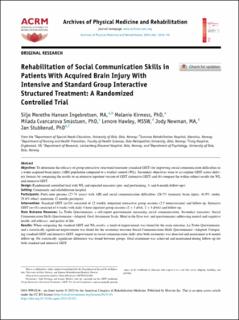| dc.contributor.author | Ingebretsen, Silje Merethe Hansen | |
| dc.contributor.author | Kirmess, Melanie | |
| dc.contributor.author | Småstuen, Milada Cvancarova | |
| dc.contributor.author | Hawley, Lenore | |
| dc.contributor.author | Newman, Jody | |
| dc.contributor.author | Stubberud, Jan Egil | |
| dc.date.accessioned | 2024-01-05T07:55:09Z | |
| dc.date.available | 2024-01-05T07:55:09Z | |
| dc.date.created | 2023-06-14T16:35:59Z | |
| dc.date.issued | 2023 | |
| dc.identifier.citation | Archives of Physical Medicine and Rehabilitation. 2023, . | en_US |
| dc.identifier.issn | 0003-9993 | |
| dc.identifier.uri | https://hdl.handle.net/11250/3109998 | |
| dc.description.abstract | Objective: To determine the efficacy of group interactive structured treatment (standard GIST) for improving social communication difficulties in a wider acquired brain injury (ABI) population compared to a waitlist control (WL). Secondary objectives were to (a) explore GIST across delivery formats by comparing the results to an intensive inpatient version of GIST (intensive GIST) and (b) compare the within-subject results for WL and intensive GIST. Design: Randomized controlled trial with WL and repeated measures (pre- and posttraining, 3- and 6-month follow-ups). Setting: Community and rehabilitation hospital. Participants: Forty-nine persons (27-74 years) with ABI and social communication difficulties (26.5% traumatic brain injury, 44.9% stroke, 28.6% other), minimum 12 months postinjury. Intervention: Standard GIST (n=24) consisted of 12 weekly outpatient interactive group sessions (2.5 hours/session) and follow-up. Intensive GIST (n=18) consisted of 4 weeks with daily 4-hour inpatient group sessions (2 £ 3 d/wk, 2 £ 4 d/wk) and follow-up. Main Outcome Measures: La Trobe Questionnaire, a self-report questionnaire measuring social communication. Secondary measures: Social Communication Skills Questionnaire−Adapted, Goal Attainment Scale, Mind in the Eyes test, and questionnaires addressing mental and cognitive health, self-efficacy, and quality of life. Results: When comparing the standard GIST and WL results, a trend of improvement was found for the main outcome, La Trobe Questionnaire, and a statistically significant improvement was found for the secondary outcome Social Communication Skills Questionnaire−Adapted. Comparing standard GIST and intensive GIST, improvement in social communication skills after both treatments was detected and maintained at 6-month follow-up. No statistically significant difference was found between groups. Goal attainment was achieved and maintained during follow-up for both standard and intensive GIST. | en_US |
| dc.language.iso | eng | en_US |
| dc.relation.uri | https://www.archives-pmr.org/article/S0003-9993(23)00164-8/fulltext | |
| dc.rights | Navngivelse 4.0 Internasjonal | * |
| dc.rights.uri | http://creativecommons.org/licenses/by/4.0/deed.no | * |
| dc.title | Rehabilitation of Social Communication Skills in Patients With Acquired Brain Injury With Intensive and Standard Group Interactive Structured Treatment: A Randomized Controlled Trial | en_US |
| dc.type | Peer reviewed | en_US |
| dc.type | Journal article | en_US |
| dc.description.version | publishedVersion | en_US |
| cristin.ispublished | true | |
| cristin.fulltext | original | |
| cristin.qualitycode | 1 | |
| dc.identifier.doi | 10.1016/j.apmr.2023.02.023 | |
| dc.identifier.cristin | 2154593 | |
| dc.source.journal | Archives of Physical Medicine and Rehabilitation | en_US |
| dc.source.pagenumber | 0 | en_US |

